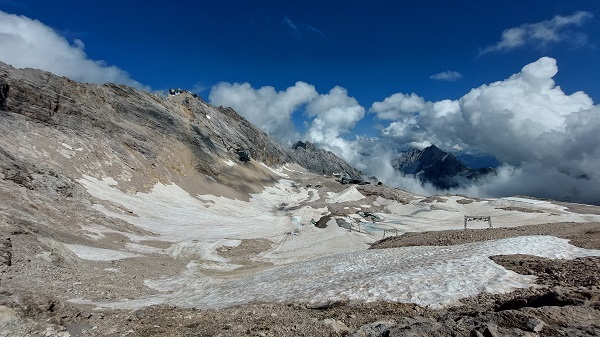Excursion Report: Snow and Ice in the Alps
A Critical Examination of Glacial Retreat and Its Implications
29.07.2024
by Makmal Abylova, Environmental Studies Certificate Student, Rachel Carson Center LMU
Our recent two-day excursion, following our course on "Snow and Ice in the Alps – Last Chance for Science and Tourism" at RCC, provided a profound exploration of the rapidly disappearing glaciers in the Bavarian Alps. With guidance of Dr. Anna-Maria Walter and Floris Winckel, we learned more about urgent challenges facing Germany's remaining glaciers and the broader implications for climate science and tourism.

Day 1: The vulnerability of Alpine glaciers
On the morning of July 29th, we set out early from Munich, making our way to the Schneefernerhaus atop Zugspitze, the highest peak in Germany. From there, we hiked to the Nördliche Schneeferner glacier. Standing at 2,600 meters above sea level, we couldn't help but feel the immense power of the natural forces that have shaped this landscape over thousands of years, now increasingly altered by global warming. Seeing the Südliche Schneeferner, which lost its status as a glacier in 2022 and is now classified as "dead ice," was a stark and sobering reminder of just how quickly things are changing in these high-altitude environments.
Our day followed with group discussions on the role of mountains in scientific research, emphasizing the interdisciplinary nature of climate studies. The loss of these glaciers is not just a scientific concern but also a cultural and socio-political issue. These discussions deepened our understanding of how scientific data intersects with public perception and policy-making.
Day 2: The role of research and collaboration
On the second day, we had the opportunity to delve deeper into the scientific research surrounding climate change by preparing presentations on topics, from Alpine ice cores to satellite remote sensing. These presentations emphasized the importance of using diverse data sources to gain a comprehensive understanding of climate change. Additionally, we were introduced to the crucial research being conducted at the Schneefernerhaus environmental research station. During a guided tour with the Scientific Coordinator, Dr. Till Rehm, we learned about the station's role as a hub for 10 globally renowned research organizations working together to monitor and analyze climate changes.
What stood out to me was how the data collected at Schneefernerhaus not only feeds into global climate models but also plays a key role in refining local climate projections and shaping policy decisions. The station’s collaborative nature fosters the exchange of innovative ideas, making it a key player in addressing the complexities of climate change.
As social science students, we also reflected on how we fit into this scientific narrative. During one of our sessions, we explored the idea that science and data are not entirely objective—they often reflect the perspectives and agendas of those who collect and interpret them. This discussion highlighted the importance of taking a more reflective approach when it comes to climate data. By contextualizing scientific findings, we can critically assess the assumptions underlying climate models and ensure that diverse perspectives are included in decision-making processes.
Reflections on the future
The disappearance of glaciers like the Nördliche Schneeferner isn't just a local problem, it is a global warning sign. Glaciers are often seen as the "voice of the Earth," and their retreat is a clear signal of the changes happening to our climate (Sörlin, 2016). This trip was more than just an academic exercise for us—it felt like a call to action. The need for urgent climate action couldn't be clearer, and it's up to all of us to make sure that what we learn from these vanishing landscapes leads to real change.
References:
Sörlin, S. (2016). Do glaciers speak? The political aesthetics of vo/ice. In S. Sörlin & L. Robin (Eds.), Methodological challenges in nature-culture and environmental history research (1st ed., pp. 18-36). Routledge. https://doi.org/10.4324/9781315665924

